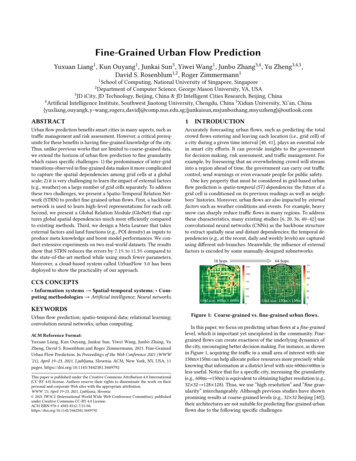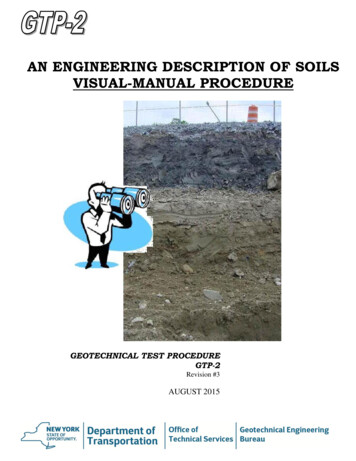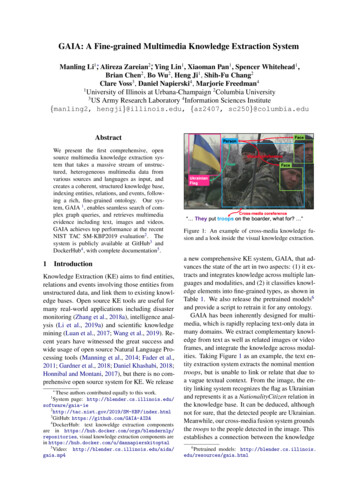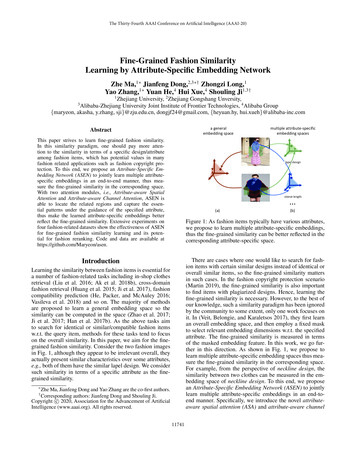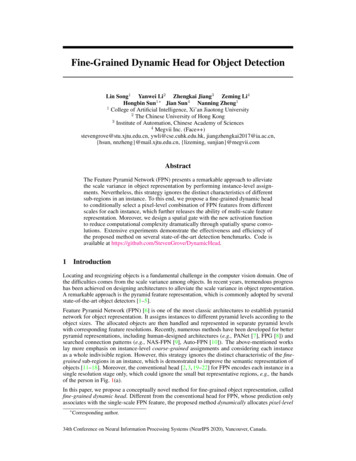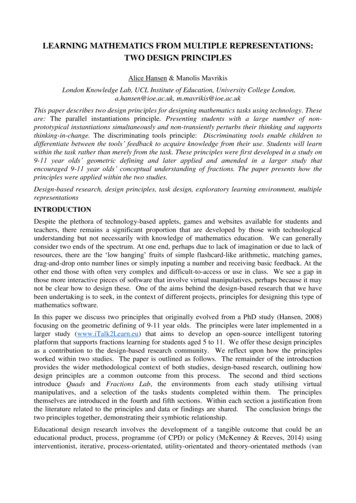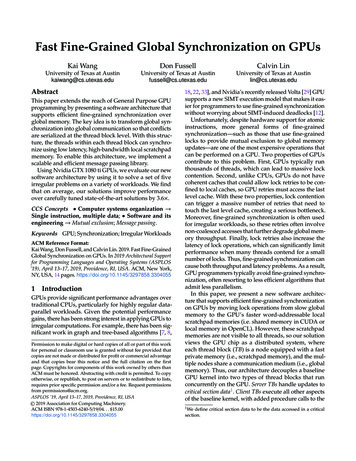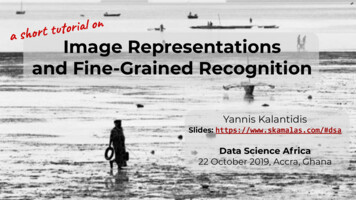
Transcription
nolairotuta shortImage Representationsand Fine-Grained RecognitionYannis KalantidisSlides: https://www.skamalas.com/#dsaData Science Africa22 October 2019, Accra, Ghana
Overview Introduction Convolutional Neural Networks (CNNs) Basic components and architecturesPytorch exampleTraining Convolutional Neural Networks What is a “representation”?Extracting vs. Learning RepresentationsLoss function and regularizationImportant tips for training image modelsFine-grained recognition Best practices for fine-grained RecognitionTackling small and imbalanced datasets
Overview Introduction Convolutional Neural Networks (CNNs) Basic components and architecturesPytorch exampleTraining Convolutional Neural Networks What is a “representation”?Extracting vs. Learning RepresentationsLoss function and regularizationImportant tips for training image modelsFine-grained recognition Best practices for fine-grained RecognitionTackling small and imbalanced datasets
What is a “representation”?ICLR 2020:The first major ML conference to take place in Africa (Addis Ababa,Ethiopia, April 2020) during the last decades
What is a “representation”?“Representation” or ”feature” in Machine Learning:(usually) a compact vector that describes the input data
What is an image/visual representation?in Computer Vision(usually) a compact vector that describes the visual content of an imageA global image representation a high-dimensional vector a set of classes present
What is an image/visual representation?in Computer Vision(usually) a compact vector that describes the visual content of an imageA global image representation a high-dimensional vector a set of classes presentBut can also be multiple local features a histogram of edges or gradients a set of regions of interest and their features
Comparing visual representations Measure similarity/distance between images. Let
What are visual representations useful for?Classification Given a set of classes/labels and an unseen image, classify the imageDetection/Segmentation Use multiple features, usually from a set of regionsVideo understanding Tracking and spatio-temporal localizationCross-modal search and generation Image captioning and description
Image Classification Given a set of classes/labels and an unseen image, classify the imageDatasets: ImageNet (meh) .or identify snake species [1], crops fromspace [2] or cassava leaf diseases [3]We need to learn a classifier on top of the representations[1] Snake species classification challenge[2] Farm Pin Crop Detection Challenge @ zindi.africa[3] iCassava Challenge 2019
Image Classification: iCassava 2019Paper: https://arxiv.org/pdf/1908.02900.pdf
Extracting vs. Learning Representations
Extracting vs. Learning RepresentationsFeature Extraction:“hand-crafted” representations Utilizes domain knowledgeRequires domain expertiseMost common approach fordecades
Extracting vs. Learning RepresentationsRepresentation Learning Don’t design featuresDesign models thatoutput representationsand predictionsDon’t tell the modelhow to solve your task;tell the model whatresult you want to get
Extracting vs. Learning RepresentationsRepresentation Learning1) Collect a dataset ofimages and labels2) Use machine learningto train a model andclassifier3) Evaluate on newimages
Learning Image RepresentationsDataset ImagesLabels/Annotations[CIFAR10 dataset]
Learning Image RepresentationsModel Use dataset to learn the parameters of a model that gives you arepresentation and a classifierGiven the model and classifier, predict the label for a newimageWhich model to use?Deep Convolutional Neural Networks
Overview Introduction Convolutional Neural Networks (CNNs) Basic components and architecturesPytorch exampleTraining Convolutional Neural Networks What is a “representation”?Extracting vs. Learning RepresentationsLoss function and regularizationImportant tips for training image modelsFine-grained recognition Best practices for fine-grained RecognitionTackling small and imbalanced datasets
Convolutional Neural Networks (CNNs)Slide Credits: Li, Johnson & Yeung, Stanford 2019
Why “Deep” Networks? Inspiration from mammal brains [Rumelhart et al 1986] Train each layer with the representations ofthe previous layer to learn a higher levelabstraction Pixels Edges Contours Object parts Object categories Local Features Global Features
Data/Input representation: Pixel intensitiesSlide Credits: Li, Johnson & Yeung, Stanford 2019
Data/Input representation: Pixel intensitiesRGB data tensorSlide Credits: Li, Johnson & Yeung, Stanford 2019
Data/Input representation: Pixel intensitiesMulti-spectral data
Convolutional Neural Networks (CNNs)Basic components: Fully Connected layerConvolutionsActivation ual Connections
Fully Connected Layere.g. a 32x32x3 image stretch to3072 x 1 (spatial structure is lost)Slide Credits: Li, Johnson & Yeung, Stanford 2019
Fully Connected LayerinputdimensionoutputdimensionSlide Credits: Li, Johnson & Yeung, Stanford 2019
Convolution Layer32 x 32 x 3 imagepreservespatialstructureSlide Credits: Li, Johnson & Yeung, Stanford 2019
Convolution Layer32 x 32 x 3 image5 x 5 x 3 filterSlide Credits: Li, Johnson & Yeung, Stanford 2019
Convolution Layer32 x 32 x 3 image5 x 5 x 3 filterConvolve the filter with theimage i.e., “slide over the imagespatially, computing dotproducts”Slide Credits: Li, Johnson & Yeung, Stanford 2019
Convolution LayerSlide Credits: Li, Johnson & Yeung, Stanford 2019
Convolution LayerSlide Credits: Li, Johnson & Yeung, Stanford 2019
Convolution Layera second filterSlide Credits: Li, Johnson & Yeung, Stanford 2019
Convolution Layerfor 6 filters, output is 28 x 28 x 6Slide Credits: Li, Johnson & Yeung, Stanford 2019
Convolution LayerSlide Credits: Li, Johnson & Yeung, Stanford 2019
Convolution LayerSlide Credits: Li, Johnson & Yeung, Stanford 2019
Convolution LayerSlide Credits: Li, Johnson & Yeung, Stanford 2019
Convolution LayerSlide Credits: Li, Johnson & Yeung, Stanford 2019
Convolution LayerSlide Credits: Li, Johnson & Yeung, Stanford 2019
Convolution Layer - strideSlide Credits: Li, Johnson & Yeung, Stanford 2019
Convolution Layer - strideshrinking too fast!Slide Credits: Li, Johnson & Yeung, Stanford 2019
Convolution Layer - padding input 7x73x3 filterstride 1pad with 1 pixel borderwhat is the output?Slide Credits: Li, Johnson & Yeung, Stanford 2019
Convolution Layer - padding input 7x73x3 filterstride 1pad with 1 pixel border7x7 outputIt is common to see conv layers withstride 1, filters of size FxF, andzero-padding with (F-1)/2. (willpreserve size spatially)Slide Credits: Li, Johnson & Yeung, Stanford 2019
Activation Function: ReLUSlide Credits: Li, Johnson & Yeung, Stanford 2019
Pooling Layer Subsampling/downsamplingoperates on each activation mapindependentlyTypical pooling functions: max averageSlide Credits: Li, Johnson & Yeung, Stanford 2019
Pooling Layer: Max poolingSlide Credits: Li, Johnson & Yeung, Stanford 2019
Putting it all togetherSlide Credits: Li, Johnson & Yeung, Stanford 2019
Residual Connections [He et al. 2016]Kaiming He, Xiangyu Zhang, Shaoqing Ren, & Jian Sun. “Deep ResidualLearning for Image Recognition”. CVPR 2016.
ResNet [He et al. 2016]Simple but deep design: all 3 x 3 conv spatial size / 2 # filters x 2(same complexity per layer) Global Average Pooling (GAP)
ResNet [He et al. 2016]
Pytorch examplehttps://pytorch.org/hub/pytorch vision resnet/
Pytorch examplehttps://pytorch.org/hub/pytorch vision resnet/
Pytorch examplehttps://pytorch.org/hub/pytorch vision resnet/
Pytorch examplehttps://pytorch.org/hub/pytorch vision resnet/
Recent advances on (hand-crafted)Convolutional Neural Network architectures(*incomplete and biased list warning) ResNeXt [CVPR 2017]Inception-v4 [AAAI 2017]Squeeze-Excitation Nets [CVPR 2018]Non-Local Networks [CVPR 2018]EfficientNet [ICML 2019]Global Reasoning Networks [CVPR 2019]Octave Convolutions [ICCV 2019]all the approaches above come with open-source code and modelshttps://paperswithcode.com/
Recent advances in CNN architecturesNeural Architecture Search AutoML NeurIPS 2018 Tutorial [U. Freiburg, U. Eindhoven]Neural Architecture Search with Reinforcement Learning [Google]NAS state-of-the-art overview [Microsoft]
Overview Introduction Convolutional Neural Networks (CNNs) Basic components and architecturesPytorch exampleTraining Convolutional Neural Networks What is a “representation”?Extracting vs. Learning RepresentationsLoss function and regularizationImportant tips for training image modelsFine-grained recognition Best practices for fine-grained RecognitionTackling small and imbalanced datasets
How to train a CNN model?(Mini-batch) Stochastic Gradient Descent (SGD)Loop:1. Sample a batch of data2. Forward prop it through the model3. Calculate loss function4. Backprop to calculate the gradients5. Update the parameters using the gradientSlide Credits: Li, Johnson & Yeung, Stanford 2019
How to train a CNN model?Loss function input dataCross entropy lossSlide Credits: Li, Johnson & Yeung, Stanford 2019
How to train a CNN model?(most commonly used) Optimizer Stochastic Gradient Descent (SGD) with momentum
How to train a CNN model?Regularizationa.k.a. Weight decay(see also [Zhang et al. ICLR 2019])Slide Credits: Li, Johnson & Yeung, Stanford 2019
Learning Rate (LR) Which LR to use? a) Start large and decay; b) use warm-up.Slide Credits: Li, Johnson & Yeung, Stanford 2019
Very important training tips Batch Normalization [Ioffe & Szegedy 2015] make each dimension zero-mean unit-variance also LayerNorm, GroupNorm, and others
Very important training tips Data preprocessing Subtract per-channel mean and divide by per-channel std dev.
Very important training tips Data preprocessing Subtract per-channel mean and divide by per-channel std dev. Data Augmentation
Very important training tips Data preprocessing Subtract per-channel mean and divide by per-channel std dev. Data Augmentation Auto Augment Mixup Training: Train on randomblends of imagesTesting: Use Originalimages
Very important training tips Data preprocessing Subtract per-channel mean and divide by per-channel std dev. Data Augmentation Auto Augment Mixup Weight initialization MSRA init (for ReLU nets): rand * sqrt(2 / din) Lottery ticket hypothesis [ICLR 2018] Deconstructing Lottery Ticket Hypothesis [ICLR 2019]
Overview Introduction Convolutional Neural Networks (CNNs) Basic components and architecturesPytorch exampleTraining Convolutional Neural Networks What is a “representation”?Extracting vs. Learning RepresentationsLoss function and regularizationImportant tips for training image modelsFine-grained recognition Best practices for fine-grained RecognitionTackling small and imbalanced datasets
Fine-grained RecognitionImage Classification Challenges Small inter-class varianceLarge intra-class variancePlus possibly: Fewer data overall per classLarge number of classesImbalanced data per class
6th Fine-Grained Visual Categorization (FGVC)Workshop at CVPR 2019More realistic competitions: iNaturalist challengefashionproductswildlife camera trapsbutterflies & mothscassava leaf disease (iCassava)6th Fine-Grained Visual Categorization Workshop @ CVPR 2019
Fine-Grained Recognition in two steps1) Start from a state-of-the-art (possible pre-trained) model2) Fine-tune depending on amount of available data & computeNote: Lots of paper are lately proposing architectures,regularizations and tweaks specific for fine-grained recognition;the above recipe, however, if training is done “the right way”, canempirically give results almost as good as the best of those.
Start from a state-of-the-art model Pick one of the best models wrt your resources small: Mobilenet, ShuffleNet, EfficientNet, etcmedium: (SE-)/(Oct-)ResNe(X)t50, etclarge: SENet-154, Inception-v4, (SE-)/(Oct-)ResNe(X)t-152, etcStart from a model pre-trained on a large dataset Pre-train dataset as close to the target domain as possible [Ciu et al CVPR 2018]Lots of publicly available models! Check the github pages of the latest architectures Models after training from 1 Billion images from FB
Pre-trained vs train from scratch Train a model from scratch withthe data Fine-tune a pre-trained model Utilize representations learnedfrom a pre-trained modelHigherExpectedperformanceLower
Pre-trained vs train from scratch Train a model from scratch withthe data Fine-tune a pre-trained model Utilize representations learnedfrom a pre-trained modelA lotDatarequiredLittle tonone
Fine-tune the modelHow much data/computing power do you have? Lots Moderate Consider training from scratchFine-tune the full model with a lower learning rateFine-tune the last few layers of the model with a lower learning rateSmall Train only the classifierconsider a 1-NN classifier! (surprisingly competitive, no training needed)
Best practices for fine-grained recognition Utilize all the “general” best practices Data PreprocessingData AugmentationCarefully tune Weight decay, Learning Rate and scheduleAlso possibly helpful: Label smoothing, Test-time augmentation Utilize any extra domain knowledge (eg part annotations) Utilize unlabeled data from the target domain if available(semi-supervised learning)
Dealing with small datasets orsmall inter-class variance Data augmentation is highly important Feature normalization is highly important try L2-norm, centering, PCATest-time augmentations auto augment, mixup, manifold-mixup, generate/hallucinate new data,multiple cropsMulti-resolution testing, model ensemblesTrain and test image resolution is very important [Cui et al. CVPR 2018], [Touvron et al 2019]Many tricks in the [FGVC6 iNaturalist 2019 challenge winner slides]
Dealing with small datasets orsmall inter-class variance Weakly Supervised Localization with CAM Attention-based architectures [Fu et al. CVPR 2017], [Zheng et al. CVPR 2019]simplest case: post-hoc add and learn anattention layer before the global average poolingGAP Generalized mean pooling (GeM) [Zhou et al. CVPR 2016][Radenovic et al PAMI 2018]Regularizers for multi-scale learning [Luo et al. ICCV 2019]
Dealing with imbalanced data(“long-tailed recognition”) Label-Distribution-Aware Margin Loss[Cao et al., NeurIPS 2019]Class-balanced loss [Cui et al. CVPR 2019]Decouple representation from classifierlearning [under review] Learn representation without caringabout imbalance, fine-tune usinguniform sampling .or just re-balance the classifierresults on iNaturalist 2018(8k species, long-tail)
Summary Introduction Convolutional Neural Networks (CNNs) Basic components and architecturesPytorch exampleTraining Convolutional Neural Networks What is a “representation”?Extracting vs. Learning RepresentationsLoss function and regularizationImportant tips for training image modelsFine-grained recognition Best practices for fine-grained RecognitionTackling small and imbalanced datasets
Resources All pytorch tutorials: https://pytorch.org/tutorials/ Tutorials on image classification, transfer learning and fine-tuning Pre-trained models to start from: ImageNet iNaturalist pre-trained models (tensorflow) [Ciu et al CVPR 2018]Models trained on 1 Billion images from IG hashtags from Facebook: WSL-Images models (pytorch) [Mahajan et al CVPR 2018] SSL/ SWSL models (pytorch) new! [Yalniz et al 2019]Great resource for going deeper (with video lectures): Stanford CS231n
Thank you! Questions?Slides: https://www.skamalas.com/#dsa
6th Fine-Grained Visual Categorization Workshop @ CVPR 2019. 1) Start from a state-of-the-art (possible pre-trained) model 2) Fine-tune depending on amount of available data & compute Note: Lots of paper are lately proposing architectures, regularizations and tweaks specific for fine-grained recognition;
